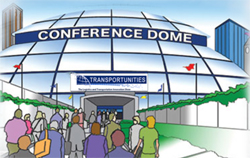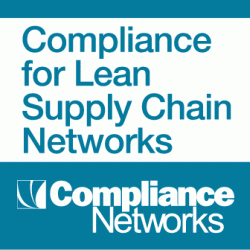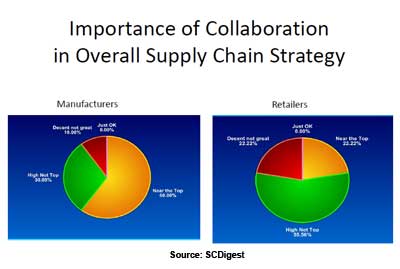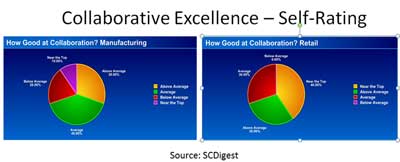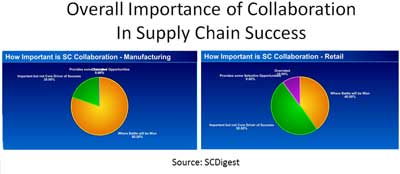 |
September 18, 2014 - Supply Chain Flagship Newsletter |
 |
| FEATURED SPONSOR: COMPLIANCE NETWORKS |
||
 |
||
Vendor Performance Impact on Safety Stock Videocast, WebEDI, Retail Supply Chain Special Reports and more |
||
 |
|
|||||||||||||||||||||||||||||||||||||||||||||||||||||||||||||||||||||||||
Of course, maybe it has always been this way. As I often note, the long string of initiatives that have been promoted in the industry - Quick Response, Efficient Consumer Response (ECR), continuous replenishment, Collaborative Planning, Forecasting, and Replenishment (CPFR), RFID and more (what am I missing?) have in general each used almost identical language in terms of the describing opportunities and benefits from tighter collaboration. There have been a few examples of where manufacturer-retailer collaboration can go. My favorite example is the process between Lowes and Whirlpool, in which the two companies run a joint sales and operations planning process (under a more retail sounding name for it), such that the two firms largely operate as if they are a single company. It is quite impressive - and successful. Why don't we have more of it? All kinds of reasons, of course, but I am convinced a good part of it is that the two sides simply see the problems/opportunities differently. I will say it this way: in general, manufacturers are more interested in deeper end-to-end collaborative processes; retailers' thinking is something like "here is the data, now just make damn sure the product is here." That is a great simplification, of course, but yet I think is largely on target. It goes back to the early days of CPFR, when the joke was from the retailers' perspective was that it was really "cpfR" - the process was all about replenishment. Once or twice a year, I am invited to JDA Software's excellent demand optimization council (DOC), a gathering of some of its top consumer goods and retail customers to discuss key cross-sector issues. I usually participate meaningfully in some way, and am very limited in what I can report back, due to the confidential nature of the discussions and presentations. Even though there were only a little over 20 respondents, about equally split between retailers and manufacturers, I feel the results would not be materially different if I had surveyed 200 companies- and the DOC members largely agreed with me. So, let's start here: how important do retailers and manufacturers view collaboration? As shown below (you can link out to large image), 60% of manufacturers believe supply chain collaboration is "near the top" in terms of importance; the number for retailers was just 22%. While many retailers believed collaboration was "high but not top" of importance, I believe the difference in perspectives is real and meaningful. Retailers do not view collaboration as being as important as manufacturers do.
I also asked the group about barriers to better collaboration with their retail/manufacturing partners. Interestingly, both sides saw the lack of the "right tools" as very high in importance, and I was a little surprised frankly that neither side saw the lack of skills/capabilities of the other side as being a top barrier (though it was cited for sure). More interesting in this area may be in the comments. Relative to collaboration barriers, one manufacturer cited the following: "Bi-lateral versus cross-vendor collaboration - meaning it is not just about sharing production schedules but also getting the carriers, freight forwarders and distributors involved." We next asked participants to rate themselves on their level of collaborative excellence - very interesting. The data may be a little tough to see even in the full size image below, but just 10% of manufacturers believed they are "near the top" in terms of collaborative skills, while 40% of retailers put themselves in that category. All told, 70% of retailers said they were either "near the top" or "above average," versus just 40% for manufacturers.
Finally, what's the bottom line in terms of how collaboration fits into overall supply chain strategies? 80% of manufacturers said "it's where the battle will be won or lost," versus just 40% of retailers who felt this way, as shown below. We asked several other questions that I do not have room for here, but we will make available in next week's OnTarget newsletter under the "Trends and Issues" category. So, I think there is a bit of "manufacturers are from Mars and retailers are from Venus" going on here. The key point is that these cultural and belief-window issues are the things that probably really constrain collaborative efforts, yet are almost never talked about or discussed. Case in point: at a previous JDA DOC meeting, there was a bit of a brouhaha over the fact that as retailers began sharing time-phased forecasts to suppliers to help them with their own planning, they wondered why those supposed savings weren't coming back some way to the retailers. Good question. To achieve the promise of manufacturer-retailer collaboration, we will need to discuss and resolve the often hidden issues that are rarely reflected in the latest technology initiative from GS1/VICS, as good as those recommendations may be (though there are some interesting technology development brewing - stay tuned). Am I correct? |
||||||||||||||||||||||||||||||||||||||||||||||||||||||||||||||||||||||||||
|
||||||||||||||||||||||||||||||||||||||||||||||||||||||||||||||||||||||||||
|
||||||||||||||||||||||||||||||||||||||||||||||||||||||||||||||||||||||||||
|
|
|
YOUR FEEDBACK
We received several letters stemming from our First Thoughts column on The Coming US Logistics Cost Crack-Up?, in which SCDigest editor Dan Gilmore says a confluence of factors are coming together that could spike transportation costs 20% or more in the next few years.
Most commentators agreed with Gilmore. That includes our Feedback of the Week from Tom Miralia of Distribution Technology. You will find that letter and several others below
Feedback on the Week on the Coming US Logistics Cost Crack-Up?:
So what's shaping up is an irresistible force heading toward an immovable object. I'm thinking that the "object" is going to lose, but it won't be initially in the transportation budgets! The impact will be felt in terms of falling performance of shipper logistics networks due to carriers not "having equipment available," resulting in stock outs, missed MABDs, DC labor planning inefficiencies, and growing safety stocks. We already see it happening! But it won't be in Transportation's budget! At least not for the near future.
The less hide-bound shipper and retailer organizations will sort it out first I suppose. It's not pretty or fun from a 3PL perspective. Tom Miralia Distribution Technology
|
||
| More on Logistics Cost Crack-Up: | ||
Gilmore, a very nice person, may be optimistic regarding cost increases. In transport alone, impacts could be even greater than now expected. Add to that, enormous societal pressures to increase minimum wage, increase -significantly - traditionally low-wage scales in fast food (among other industries). Warehousing/distribution labor rates will have to increase substantially to remain even marginally attractive when compared with, relatively speaking, no-brainer, limited skills jobs.
|
||
I recently read a letter to the editor by a truck driver claiming that in his 20+ years of driving he had never seen items left at the dock due to the lack of a driver. He indicated that there is no driver shortage; that the real problem is the lack of a decent wage paid be trucking companies and other shippers. Those are the companies having a "driver shortage" problem. Companies paying better wages are not experiencing this "shortage of drivers" problem.
I personally have no real knowledge of the trucking industry so all I've read has primarily been about the shortage. But this driver's comments certainly raise an interesting point that you might want to look into. Is there a "real" shortage or are shippers just being cheap and squeezing smaller truck drivers with inadequate compensation.
Tony DeVico
|
||
Great analysis. I am glad you are bringing this to the attention of CSCMP members. I think you are spot on, if not a little on the low side. Dan Wancura Supply Chain Networking
|
SUPPLY CHAIN TRIVIA ANSWER
Q: Not really supply chain related, but fun: what are the top 5 airports worldwide in terms of passenger traffic?
A: (1) Atlanta; (2) Beijing; (3) London; (4) Tokyo; and (5) Chicago O'Hare, according to 2013 data released this week.
| © SupplyChainDigest™ 2003-2014. All Rights Reserved. SupplyChainDigest PO Box 714 Springboro, Ohio 45066 |
POWERED BY: XDIMENSION
|


